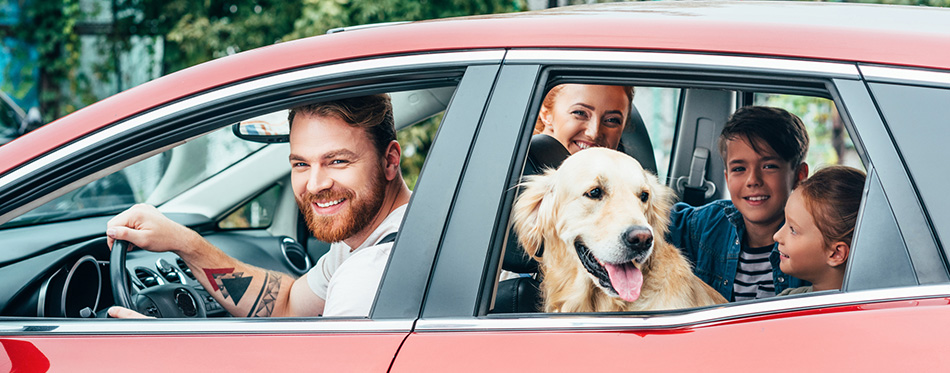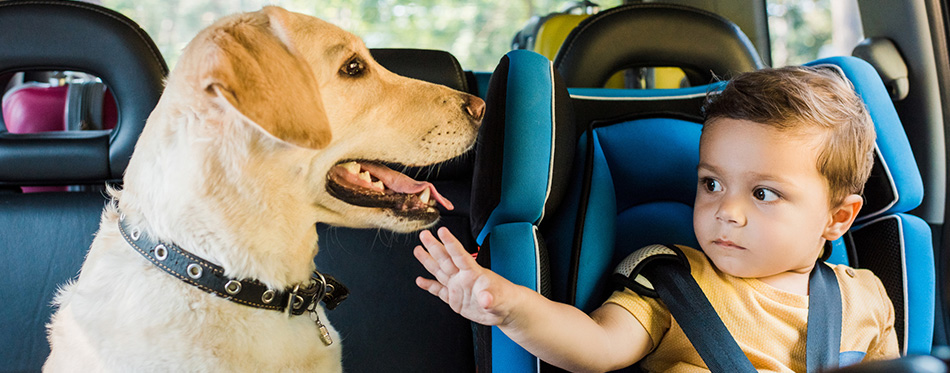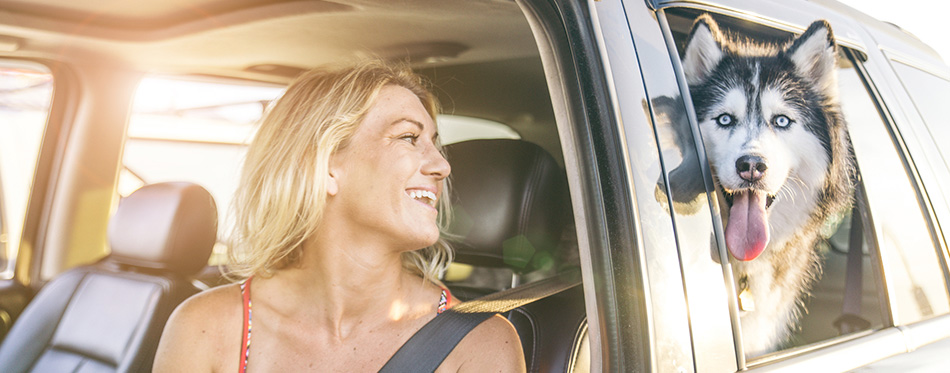Most pet owners will need to car travel with their dogs at one point or another. While this isn’t a problem for some pups, others suffer from car sickness, which is unpleasant for everyone in the car. This issue is particularly common in younger dogs who don’t have fully developed ear structures that provide balance. While some pets outgrow this issue, it continues to be a problem for others. In general, this isn’t a serious problem, and it is one that may arise for a host of reasons including excitement and stress.
In this blog post, we are going to start by looking at some of the most common symptoms of motion sickness in dogs. Following on from this, we are going to offer a few possible solutions that can help to alleviate your pooch’s suffering and ensure that both you and your pup have pleasant car rides from now on.

Can Dogs Get Carsick?
Yes, dogs can get carsick just like human beings. It is more commonly seen in young dogs and puppies than older hounds, but this is also true of kids in comparison to adults. The ear structures of puppies are not fully developed, which causes feelings of imbalance, leading to sickness. While many dogs will get past this problem, others won’t. If your dog has felt sick in the first few car rides of their life, they may start to associate car travel with sickness. Another common reason is stress. If your dog only ever gets in the car to go to the vet, they may start to worry themselves into a state of sickness. At the other end of the scale, your dog may get too excited, which can also lead to them becoming nauseated.
Symptoms of Motion Sickness in Dogs
While you may not be able to see your dog going green around the gills, there are a few common symptoms which you can probably relate to if you have ever suffered from car sickness. A few of these include yawning, vomiting, drooling, and smacking or licking lips. You may also notice that your pooch looks generally uneasy or listless. It could also be that they vocalize their upset by whining. And the most obvious symptom is that your dog actually vomits. This final one can make car journeys particularly unpleasant. Rather than ignoring these symptoms, you will help to make your dog’s life a lot more pleasant by trying to calm them down and make them feel more relaxed. Thankfully, there are plenty of ways that you can do this.
How To Help Dogs with Car Sickness
There are a number of different techniques that you can use to combat your dog’s motion sickness. Bear in mind that you may have to try out a few of them before you discover the one that works best for your pup specifically. Without further ado, here are the best ways to prevent car sickness in dogs!

Ensure Your Dog Has an Empty Stomach
Don’t feed your dog right before you get in the car or you may see that food again very quickly! If your dog suffers from bad car sickness or you are taking a particularly long journey, you may want to leave it as long as 6 to 8 hours before traveling. If you are making a shorter trip, a couple of hours may well prove to be enough. You can give your dog some water instead. Bear in mind that this only works for some dogs. Others will do better with something in their stomach before travel. Some owners have reported success by offering a sweet treat, but you should ensure that it is a dog-friendly one that doesn’t contain any poisonous substances like xylitol.
Related Post: Dog Treats
Change Car Travel Associations
If you are worried that your dog only associates car travel with negative feelings, you can try and make the experience more positive for them. First, if your dog has got sick recently and if it is possible, you could take a break from car travel for a week or two. If you can, you could try switching vehicles, so there are no negative associations with your current car. A larger vehicle will give your dog more room to spread out, which could help to alleviate any cramped feelings and possibly sickness. You can then introduce them to the vehicle gradually, taking them inside with the engine off. Make sure to speak in positive tones and offer your pooch plenty of praise. You could even get some toys that are only kept in the car, offering your pup an extra special treat when they get inside.
Related Post: Dog Toys
Instead of always taking them to the vet, bring them on a trip to the local dog park instead. Shorter journeys will be better to start off with. When you are there, make the experience as enjoyable as possible with plenty of love, attention, and games. When you arrive home again, play with your dog again. Ideally, you will have someone to calm your dog down on both parts of the journey. After your dog has calmed down again, you can offer them some treats. Keep this up and your dog should see that a trip in the calm doesn’t always have to be a negative experience. Over time, you should be able to build up to longer journeys.
Related Post: Vegan Dog Treats
Make the Ride Enjoyable
Your dog is less likely to feel nauseated if they face forward while traveling rather than looking out of the side windows. You can help to ensure this with a special dog seatbelt but be warned that airbags can pose a potential threat to them. If your dog can see out of the window, this can help them to stay focused on something that distracts them from any feelings of motion sickness.
Another alternative is to put them in a dog crate. This also has the added advantage of containing any vomit if your pooch gets sick along the way. And once they are properly crate trained, this can be treated as a safe space, which helps your dog to feel at ease. You could also try lowering the car window a couple of inches to allow a through draught. Keep the car cool and well ventilated throughout the journey as stuffiness can worsen motion sickness. If it is not possible to open up the windows, you could use the A/C for this purpose instead.
Head over to our reviews of Dog Car Seats, Car Seat Covers and Dog Car Barriers for more choices.
Make Frequent Stops Along the Way
If you are going to be traveling for an extended period of time, you should consider making plenty of stops along the way. While some dogs can deal with being in the car for a long time at once, others don’t like it at all. Try stopping the car every one or two hours to stretch your legs and take a bathroom break. You could also use this time as a water break.
Travel with Someone to Distract Your Dog
If you travel in a car on your own, it can be tough to manage your dog’s car sickness. But if you have someone else to help deal with it, this can help to keep your dog distracted. They can speak to them in comforting tones throughout the journey and play some games too. Bring along some of your dog’s favorite toys and this can help to put your pooch at ease during the journey.
Try Some Medical Remedies
If nothing else seems to work from your conditioning techniques, there are medical solutions as well. There is plenty of over the counter medication out there including anti-nausea drugs, antihistamines, and prescription drugs. Make sure that you consult with your vet before offering your dog any medication to ensure that it is safe, and you know the correct dosage to give. Vets often prescribe Dramamine, a common antihistamine which humans also take for motion sickness. There are also dog anxiety medications out there which could prove to help. Work closely with your vet to determine the essential issues such as the timing of the medication. You need to know about any potential side effects too.
You could also try some natural remedies. One such option is ginger – capsules are readily available from health food and drug stores. There are also dog-friendly gingersnap cookies out there, which provide a nice alternative.

Final Thoughts
Dog motion sickness is a common condition in puppies and younger dogs, but it also continues to be a problem in some older dogs too. Many of the symptoms are similar to the ones that we suffer from as humans, including nausea and vomiting, and they can also include drooling, yawning, and licking lips. If your dog doesn’t grow out of the issue, there are a number of different treatment options out there including behavioral solutions, changes that you can make within the vehicle, and medicines. Consult with your vet about the latter to make sure that you determine a safe dosage. Ultimately, there is no single approach that is going to work for every dog, and you may need to experiment before you determine what works best for your pooch.
Sources:
- Canine Car Sickness – Wisconsin Humane Society
- Motion Sickness in Dogs – TexVetPets

